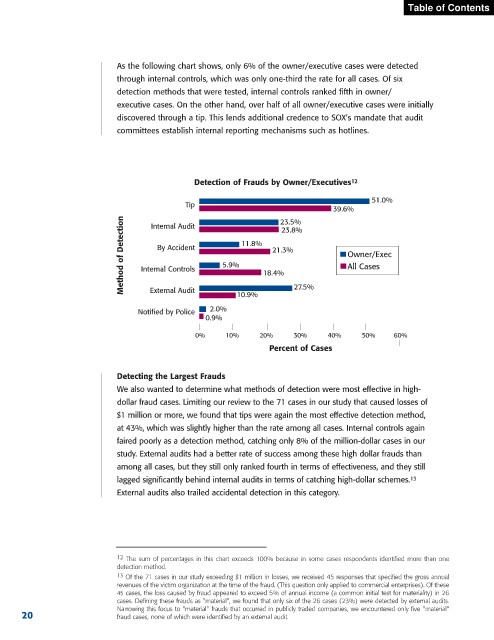Page 86 - ACFE Fraud Reports 2009_2020
P. 86
Table of Contents
As the following chart shows, only 6% of the owner/executive cases were detected
through internal controls, which was only one-third the rate for all cases. Of six
detection methods that were tested, internal controls ranked fifth in owner/
executive cases. On the other hand, over half of all owner/executive cases were initially
discovered through a tip. This lends additional credence to SOX’s mandate that audit
committees establish internal reporting mechanisms such as hotlines.
Detection of Frauds by Owner/Executives 12
51.0%
Tip
39.6%
Method of Detection Internal Controls 5.9% 11.8% 18.4% Owner/Exec
23.5%
Internal Audit
23.8%
By Accident
21.3%
All Cases
External Audit
2.0% 10.9% 27.5%
Notified by Police
0.9%
0% 10% 20% 30% 40% 50% 60%
Percent of Cases
Detecting the Largest Frauds
We also wanted to determine what methods of detection were most effective in high-
dollar fraud cases. Limiting our review to the 71 cases in our study that caused losses of
$1 million or more, we found that tips were again the most effective detection method,
at 43%, which was slightly higher than the rate among all cases. Internal controls again
faired poorly as a detection method, catching only 8% of the million-dollar cases in our
study. External audits had a better rate of success among these high dollar frauds than
among all cases, but they still only ranked fourth in terms of effectiveness, and they still
lagged significantly behind internal audits in terms of catching high-dollar schemes. 13
External audits also trailed accidental detection in this category.
12 The sum of percentages in this chart exceeds 100% because in some cases respondents identified more than one
detection method.
13 Of the 71 cases in our study exceeding $1 million in losses, we received 45 responses that specified the gross annual
revenues of the victim organization at the time of the fraud. (This question only applied to commercial enterprises). Of these
45 cases, the loss caused by fraud appeared to exceed 5% of annual income (a common initial test for materiality) in 26
cases. Defining these frauds as "material", we found that only six of the 26 cases (23%) were detected by external audits.
Narrowing this focus to "material" frauds that occurred in publicly traded companies, we encountered only five "material"
20 fraud cases, none of which were identified by an external audit.

